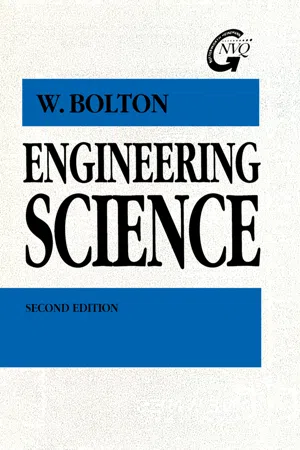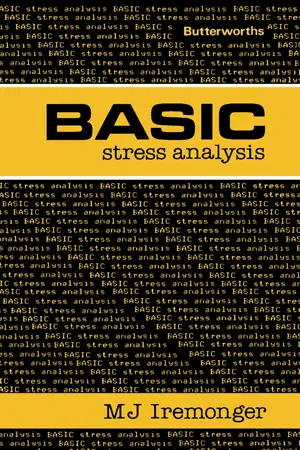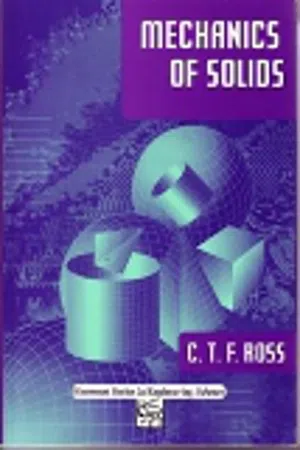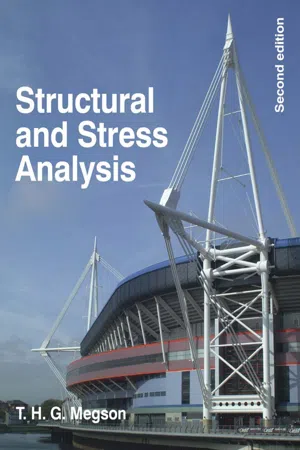Technology & Engineering
Shear Strain
Shear strain refers to the deformation that occurs when parallel surfaces within a material slide past each other in response to applied shear stress. It is a measure of the change in shape or distortion of the material due to shear forces. Shear strain is typically expressed as the ratio of the displacement between the parallel surfaces to the original distance between them.
Written by Perlego with AI-assistance
Related key terms
1 of 5
10 Key excerpts on "Shear Strain"
- eBook - PDF
- William Bolton(Author)
- 2016(Publication Date)
- Newnes(Publisher)
Shear stress and strain Area over which force applied is A rqe Figure 6.3 A cube subject to shear forces Figure 6.3 shows how a material can be subject to shear. The forces are applied in such a way as to tend to slide one layer of the material over an adjacent layer. With shear the area over which forces act is in the same plane as the lines of action of the forces. The force per unit area is called the shear stress: shear stress = force area The unit of shear stress is the pascal (Pa). With tensile and compressive stresses the deformations produced are changes in length, extensions or contractions. With shear stress the deformation produced is an angular deformation φ. Shear Strain is defined as the angle φ. Shear Strain = φ The unit used for φ is the radian, and since the radian is a ratio then Shear Strain can be expressed either in units of radians or without units. For the shear shown in Figure 6.3, Stress and strain 103 tan φ = For small angles tan φ is virtually the same as φ expressed in radians. Thus Shear Strain = This clearly indicates the ratio nature of Shear Strain. Figure 6.4 shows an example of shear occurring in a fastening, in this case riveted joints. In Figure 6.4a, a simple lap joint, the rivet is in shear as a result of the forces applied to the plates joined by the rivet. The rivet is said to be in single shear, since there is just one plane (A) subject to the shear forces. In Figure 6.4b rivets are used to produce a double cover butt joint. With this form of joint the rivets are said to be in double shear since two planes (A and B) are subject to the shear forces. r^ -' L %7 ^ ^ h i (a) 1 l· — > r 1 IE (b) V . A 1 t-H J ^. ~2}~~~~ F X T i ' 1 i y Figure 6.4 Riveted joints: (a) a lap joint (b) a double cover butt joint The shear strength of a material is the maximum shear stress that the material can withstand before failure occurs. - eBook - PDF
- M J Iremonger(Author)
- 2013(Publication Date)
- Butterworth-Heinemann(Publisher)
Chapter 4 Shear and torsion ESSENTIAL THEORY 4.1 Shear stress Shear stress is the stress component parallel to the plane on which it acts. With the notation shown in Figure 4.1 the shear stress is defined as r = Q/A (4.1) where τ represents the actual (uniform) stress if the force Q is uniformly distributed over the area A and the average stress if Q is not uniformly distributed. In the latter case the actual shear stress at any point can be defined by the limiting ratio of SQ/8A where 5^4 represents the area of a small element of material over which the stress can reasonably be assumed to be uniform. Figure 4.1 Figure 4.2 In order to preserve equilibrium every shear stress (r) is accompanied by an equal complementary shear stress on a plane at right angles as shown in Figure 4.2. 33 34 Shear and torsion 4.2 Shear Strain Shear Strain (7) is a dimensionless measure of the distortion of a rectangular element under shear. For small strains 7 = tan0 ^ 0 (4.2) where φ is the angle shown in Figure 4.2 measured in radians. 4.3 Stress-strain relations The shear stress—Shear Strain relationships are qualitatively similar to the direct stress—direct strain relationships described in Section 3.2. In the linear elastic region where Hooke's Law is obeyed, the gradient of the shear stress—strain curve is a constant called shear modulus (G, modulus of rigidity) where G = τ/γ (4.3) 4.4 Relationship between elastic constants When the material behaviour is linearly elastic and isotropic (properties independent of direction) there are only two independent elastic constants. The shear modulus (G) is related to Young's modulus (E) and Poisson's ratio (y) by the equation E = 2G(l + 1/) (4.4) If any two of the constants are known the third can be found from this equation. A fourth, less commonly used, elastic constant is bulk modulus. This represents a volumetric stress divided by volumetric strain. - Wole Soboyejo(Author)
- 2002(Publication Date)
- CRC Press(Publisher)
Similarly, for small displacements, a Shear Strain, y, can be defined as the angular displacement induced by an applied shear stress. The Shear Strain, y, is given by y = w /l = tan 0 (3.9) where y, w, / and 6 are shown schematically in Fig. 3.3(b). The angle y has units of radians. However, the Shear Strain is generally presented as a dimen-sionless quantity. It is important to note here that the above equations for the engineer-ing strain assume that the stresses are uniform across the area elements or uniform cross-sections that are being deformed. The engineering shear and axial strains must be distinguished from the so-called “true strains” which will be described in Chap. 5. Similar to stress, the engineering strain may have three uniaxial (exx, £yy, s zz) and shear (yxy, y yz, yzx) components, Fig. 3.4(a). The three-dimen- Basic Definitions of Stress and Strain 65 (a) r r~ ------------1 1 • 1 ♦ u i 1 1 1 1 2 1 1 L I 1 1 i 1 1 u i | 1 2 1 1 ♦ L I H f— * -H K I u Nominal tensile strain, €„ = ~ I Nominal lateral strain, «n = --Poisson’s ratio, v -~ lateral strain tensile strain (b) w—1 I— Engineering Shear Strain, w y * = tan w I * h for small strains F igure 3.3 Definitions of strain: (a)] uniaxial strain; (b) Shear Strain. (After Ashby and Jones, 1996. Courtesy of Butterworth-Heinemann.) sional strain components may also be perceived in terms of the simple definitions or axial and Shear Strains presented earlier (Fig. 3.3). However, the same shape change may also be resolved as an axial or Shear Strain, depending on the choice of co-ordinate system. Also, note that the displace-ment vectors along the (x, y, z) axes are usually described by displacement co-ordinates (u, v, w). The uniaxial strain, e xx, due to displacement gradient in the x direction is given by 66 Chapter 3 Similarly, the Shear Strain due to relative displacement gradient in the y- direction is given by Fig.- eBook - ePub
- Carl T. F. Ross, The late John Case, A. Chilver(Authors)
- 1999(Publication Date)
- Butterworth-Heinemann(Publisher)
5Analysis of stress and strain
5.1 Introduction
Up to the present we have confined our attention to considerations of simple direct and shearing stresses. But in most practical problems we have to deal with combinations of these stresses.The strengths and elastic properties of materials are determined usually by simple tensile and compressive tests. How are we to make use of the results of such tests when we know that stress in a given practical problem is compounded from a tensile stress in one direction, a compressive stress in some other direction, and a shearing stress in a third direction? Clearly we cannot make tests of a material under all possible combinations of stress to determine its strength. It is essential, in fact, to study stresses and strains in more general terms; the analysis which follows should be regarded as having a direct and important bearing on practical strength problems, and is not merely a display of mathematical ingenuity.5.2 Shearing stresses in a tensile test specimen
A long uniform bar, Figure 5.1 , has a rectangular cross-section of area A. The edges of the bar are parallel to perpendicular axes Ox, Oy, Oz. The bar is uniformly stressed in tension in the x-direction, the tensile stress on a cross-section of the bar parallel to Ox being σx . Consider the stresses acting on an inclined cross-section of the bar; an inclined plane is taken at an angle θ to the yz-plane. The resultant force at the end cross-section of the bar is acting parallel to Ox .Figure 5.1 Stresses on an inclined plane through a tensile test piece.For equilibrium the resulrant force parallel to Ox on an inclined cross-section is alsoP = A σx. At the inclined cross-section in Figure 5.1 , resolve the forceA σx - eBook - PDF
- Barry Goodno, James Gere, Barry Goodno(Authors)
- 2020(Publication Date)
- Cengage Learning EMEA(Publisher)
Due to electronic rights, some third party content may be suppressed from the eBook and/or eChapter(s). Editorial review has deemed that any suppressed content does not materially affect the overall learning experience. Cengage Learning reserves the right to remove additional content at any time if subsequent rights restrictions require it. Section 1.8 Shear Stress and Strain 53 The average shear stress on the cross section of a bolt is obtained by dividing the total shear force V by the area A of the cross section on which it acts, as aver V A t 5 (1-16) In the example of Fig. 1-50, which shows a bolt in single shear, the shear force V is equal to the load P, and the area A is the cross-sectional area of the bolt. However, in the example of Fig. 1-49, where the bolt is in double shear, the shear force V equals P/2. Equation (1-16) shows that shear stresses, like normal stresses, represent intensity of force, or force per unit of area. Thus, the units of shear stress are the same as those for normal stress, namely, pascals or multiples thereof in SI units. The loading arrangements shown in Figs. 1-49 and 1-50 are examples of direct shear (or simple shear) in which the shear stresses are created by the direct action of the forces trying to cut through the material. Direct shear arises in the design of bolts, pins, rivets, keys, welds, and glued joints. Equality of Shear Stresses on Perpendicular Planes To obtain a more complete picture of the action of shear stresses, consider a small element of material in the form of a rectangular parallelepiped having sides of lengths a, b, and c in the x, y, and z directions, respectively (Fig. 1-52). 4 The front and rear faces of this element are free of stress. Now assume that a shear stress 1 t is distributed uniformly over the right- hand face, which has area bc. - eBook - PDF
- William F. Hosford(Author)
- 2009(Publication Date)
- Cambridge University Press(Publisher)
In contrast, if there has been extensive plastic deformation preceding fracture, the material is con-sidered ductile . Fracture usually occurs as soon as a critical stress has been reached; however, repeated applications of a somewhat lower stress may cause fracture. This is called fatigue . The amount of deformation that a material undergoes is described by strain. The forces acting on a body are described by stress. Although the reader should already be familiar with these terms, they will be reviewed in this chapter. 1 2 Mechanical Behavior of Materials Stress Stress , σ , is defined as the intensity of force at a point. σ = ∂ F /∂ A as ∂ A → 0 . (1.1a) If the state of stress is the same everywhere in a body, σ = F / A . (1.1b) A normal stress (compressive or tensile) is one in which the force is normal to the area on which it acts. With a shear stress, the force is parallel to the area on which it acts. Two subscripts are required to define a stress. The first subscript denotes the normal to the plane on which the force acts, and the second subscript identifies the direction of the force. ∗ For example, a tensile stress in the x-direction is denoted by σ xx indicating that the force is in the x-direction and it acts on a plane normal to x. For a shear stress, σ xy , a force in the y-direction acts on a plane normal to x. Because stresses involve both forces and areas, they are not vector quantities. Nine components of stress are needed to fully describe a state of stress at a point, as shown in Figure 1.1 . The stress component, σ yy = F y / A y , describes the tensile stress in the y-direction. The stress component, σ zy = F y / A z , is the shear stress caused by a shear force in the y-direction acting on a plane normal to z. Repeated subscripts denote normal stresses (e.g., σ xx , σ yy ), whereas mixed sub-scripts denote shear stresses (e.g., σ xy , σ zx ). - eBook - PDF
- Timothy A. Philpot(Author)
- 2014(Publication Date)
- Wiley(Publisher)
Strain Units Equations (2.3) through (2.5) indicate that Shear Strains are dimensionless angular quanti- ties, expressed in radians (rad) or microradians (rad). The conversion from radians, a dimensionless quantity, to microradians is 1 rad 1 × 10 6 rad. Measuring Shear Strains Experimentally Shear Strain is an angular measure, and it is not possible to directly measure the extremely small angular changes typical of engineered structures. However, Shear Strain can be deter- mined experimentally by using an array of three strain gages called a strain rosette. Strain rosettes will be discussed in more detail in Chapter 13. Sign Conventions for Shear Strains Equation (2.5) shows that Shear Strains will be positive if the angle between the x and y axes decreases. If the angle increases, the Shear Strain is negative. To state this another way, Equation (2.5) can be rearranged to give the angle in the deformed state between two reference lines that are initially 90° apart: 2 xy If the value of xy is positive, then the angle in the deformed state will be less than 90° (i.e., 2 rad) (Figure 2.5a). If the value of xy is negative, then the angle in the de- formed state will be greater than 90° (Figure 2.5b). Positive and negative Shear Strains are not given special or distinctive names. FIGURE 2.5a A positive value for the Shear Strain xy means that the angle between the x and y axes decreases in the deformed object. x y xy – 2 FIGURE 2.5b The angle between the x and y axes increases when the Shear Strain xy has a negative value. x y xy – 2 EXAMPLE 2.2 The shear force V shown causes side QS of the thin rectangular plate to displace downward 1.6 mm. Determine the Shear Strain xy at P. Plan the Solution Shear Strain is an angular measure. Determine the angle between the x axis and side PQ of the deformed plate. SOLUTION Determine the angles created by the 1.6 mm deformation. - eBook - PDF
- Carl T. F. Ross(Author)
- 1999(Publication Date)
- Woodhead Publishing(Publisher)
-~e---Stress and Strain 2.1 Introduction The most elementary definition of stress is that it is the load per unit area acting on a surface, rather similar to pressure, except that it can be either tensile or compressive and it does not necessarily act normal to the surface, i.e. Stress = load/area (2.1) In its simplest form, stress acts at an angle to the surface, as shown in Figure 2.1. However, in the form shown in Figure 2.1, it is difficult to apply stress analysis to practical problems, and because of this, the resultant stress is represented by a normal or direct stress a, together with a shear stress, t, as shown in Figure 2.2. The stress, a, in Figure 2.2 is called a normal or direct stress because it acts Figure2.1 Figure 2.2 Normal and shear stress 54 Stress and strain 55 ~//.//.//./L • F Figure 2.3 Shearingaction of F Figure 2.4 Componentsof R perpendicularly to the surface under consideration, and the stress, r, is called a shearing stress because it acts tangentially to the surface, causing shearing action, as shown in Figure 2.3. Thus, if a flat surface is subjected to a force, R, acting at an angle to the surface, it is convenient to represent this resultant force by its two perpendicular components, namely P and F, where P acts normal to the surface and F acts tangentially to the surface, as shown in Figure 2.4. The effect of P will be to increase the length of the structural component and to cause a normal or direct stress, a, where a=PjA (2.2) and A is the cross-sectional area. - eBook - PDF
- Marko V. Lubarda, Vlado A. Lubarda(Authors)
- 2020(Publication Date)
- Cambridge University Press(Publisher)
3.3 Shear Stress–Strain Relations The shear stresses and strains for an isotropic material in the range of small elastic deformations are related by the linear relationships xy = σ xy 2G , yz = σ yz 2G , zx = σ zx 2G , (3.7) where G = E 2(1 + ν ) (3.8) is the shear modulus of the material. The relationships (3.7) and (3.8) can be derived by using (3.5), as we now demon- strate. Figure 3.6(a) shows a square plate element A 0 B 0 C 0 D 0 under pure shear stress τ acting on its four sides. The element deforms into a deltoidal shape ABCD, with its diagonals along the principal directions of stress and strain, at ±45 ◦ with respect to the x and y axes. The principal stresses (σ 1 = τ and σ 2 = −τ ), and the extracted square element on which they act, are shown in Fig. 3.6(b). The Shear Strain between the directions A 0 B 0 and A 0 D 0 , parallel to the x and y directions, is xy = 1 2 π 2 − φ , (3.9) where φ is the angle between the sides AB and AD in the deformed configuration of the material element. This angle can be determined from tan φ 2 = OB OA = OB 0 (1 + 2 ) OA 0 (1 + 1 ) = 1 + 2 1 + 1 (OB 0 = OA 0 ). (3.10) By Hooke’s law (3.5), the principal strains ( 1 and 2 ) can be expressed in terms of the principal stresses (σ 1 = τ and σ 2 = −τ ) as 1 = 1 E (σ 1 − νσ 2 ) = 1 + ν E τ , 2 = 1 E (σ 2 − νσ 1 ) = − 1 + ν E τ . (3.11) 56 Stress–Strain Relations τ τ τ τ τ τ τ τ γ γ φ y x C (2) (1) D 0 2 C 0 A 0 A B 0 D B O (a) (b) Figure 3.6 (a) The square plate element A 0 B 0 C 0 D 0 under pure shear stress τ deforms into a deltoidal shape ABCD with its diagonals along the principal directions of stress and strain, at ±45 ◦ to the x and y axes. The engineering Shear Strain corresponding to τ is γ = τ /G, where G is the shear modulus of the material. (b) The principal stresses acting on the extracted square element drawn with a dashed line, which deforms into a rectangular element drawn with a solid line. - eBook - PDF
- T.H.G. Megson(Author)
- 2005(Publication Date)
- Butterworth-Heinemann(Publisher)
The stress produced by each value of load may be calculated from Eq. (7.1) and the corresponding strain from Eq. (7.4). A stress– strain curve is then drawn which, for some materials, would have a shape similar to that shown in Fig. 7.8. Stress–strain curves for other materials differ in detail but, generally, all have a linear portion such as ab in Fig. 7.8. In this region stress is directly proportional to strain, a relationship that was discovered in 1678 by Robert Hooke and which is known as Hooke’s law . It may be expressed mathematically as σ = E ε (7.7) where E is the constant of proportionality. E is known as Young’s modulus or the elastic modulus of the material and has the same units as stress. For mild steel E is of the order of 200 kN/mm 2 . Equation (7.7) may be written in alternative form as σ ε = E (7.8) For many materials E has the same value in tension and compression. SHEAR MODULUS By comparison with Eq. (7.8) we can define the shear modulus or modulus of rigidity , G , of a material as the ratio of shear stress to Shear Strain; thus G = τ γ (7.9) VOLUME OR BULK MODULUS Again, the volume modulus or bulk modulus , K , of a material is defined in a similar manner as the ratio of volumetric stress to volumetric strain, i.e. K = volumetric stress volumetric strain (7.10) It is not usual to assign separate symbols to volumetric stress and strain since they may, respectively, be expressed in terms of direct stress and linear strain. Thus in the case 158 • Chapter 7 / Stress and Strain of hydrostatic pressure (Section 7.6) K = σ 3 ε (7.11) E XAMPLE 7.2 A mild steel column is hollow and circular in cross section with an external diameter of 350 mm and an internal diameter of 300 mm. It carries a compressive axial load of 2000 kN. Determine the direct stress in the column and also the shortening of the column if its initial height is 5 m. Take E = 200 000 N/mm 2 . The cross-sectional area A of the column is given by A = π 4 (350 2 − 300 2 ) = 25 525 .
Index pages curate the most relevant extracts from our library of academic textbooks. They’ve been created using an in-house natural language model (NLM), each adding context and meaning to key research topics.









